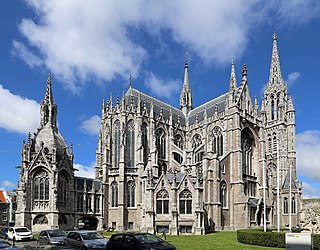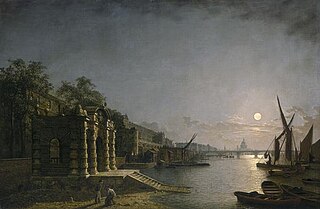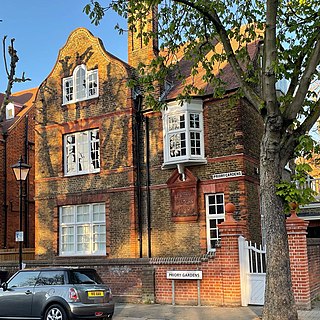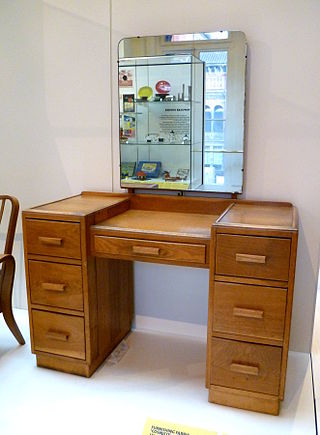Related Research Articles

Gothic Revival is an architectural movement that after a gradual build-up beginning in the second half of the 17th century became a widespread movement in the first half of the 19th century, mostly in England. Increasingly serious and learned admirers sought to revive medieval Gothic architecture, intending to complement or even supersede the neoclassical styles prevalent at the time. Gothic Revival draws upon features of medieval examples, including decorative patterns, finials, lancet windows, and hood moulds. By the middle of the 19th century, Gothic Revival had become the pre-eminent architectural style in the Western world, only to begin to fall out of fashion in the 1880s and early 1890s.

Charles Locke Eastlake was a British architect and furniture designer.
Sir Terence Orby Conran was a British designer, restaurateur, retailer and writer. He founded the Design Museum in Shad Thames, London in 1989. The British designer Thomas Heatherwick said that Conran "moved Britain forward to make it an influence around the world." Edward Barber, from the British design team Barber & Osgerby, described Conran as "the most passionate man in Britain when it comes to design, and his central idea has always been 'Design is there to improve your life.'" The satirist Craig Brown once joked that before Conran "there were no chairs and no France."

William Burges was an English architect and designer. Among the greatest of the Victorian art-architects, he sought in his work to escape from both nineteenth-century industrialisation and the Neoclassical architectural style and re-establish the architectural and social values of a utopian medieval England. Burges stands within the tradition of the Gothic Revival, his works echoing those of the Pre-Raphaelites and heralding those of the Arts and Crafts movement.

York House was one of a series of grand mansions that formerly stood on the Strand, the principal route from the City of London to the Palace of Westminster.

The Victorian Society is a UK charity and amenity society that campaigns to preserve and promote interest in Victorian and Edwardian architecture and heritage built between 1837 and 1914 in England and Wales. As a statutory consultee, by law it must be notified of any work to a listed building which involves any element of demolition or structural alteration.

The Tower House, 29 Melbury Road, is a late-Victorian townhouse in the Holland Park district of Kensington and Chelsea, London, built by the architect and designer William Burges as his home. Designed between 1875 and 1881, in the French Gothic Revival style, it was described by the architectural historian J. Mordaunt Crook as "the most complete example of a medieval secular interior produced by the Gothic Revival, and the last". The house is built of red brick, with Bath stone dressings and green roof slates from Cumbria, and has a distinctive cylindrical tower and conical roof. The ground floor contains a drawing room, a dining room and a library, while the first floor has two bedrooms and an armoury. Its exterior and the interior echo elements of Burges's earlier work, particularly Park House in Cardiff and Castell Coch. It was designated a Grade I listed building in 1949.

Utility furniture was furniture produced in the United Kingdom during and directly after World War II. The furniture was produced under a government scheme which was designed to cope with raw material shortages and rationing of their usage. Introduced at the end of 1942, the Utility Furniture Scheme continued into post-war austerity and lasted until its abolition in March 1949.
Peter Kai Thornton CBE was a museum curator and writer.
Penelope Anne "Penny" Sparke is a British writer and academic specialising in the history of design. She has been Professor of Design History at Kingston University, London, since 1999, where she is also Director of the Modern Interiors Research Centre.

A klismos or klismos chair is a type of ancient Greek chair, with curved backrest and tapering, outcurved legs.

Bruce James Talbert was a Scottish architect, interior designer and author, best known for his furniture designs.

The Great Bookcase is a large piece of painted furniture designed by the English architect and designer William Burges.
John Adamson is a British publisher, translator and writer. He specialises in illustrated books in the fine and decorative arts.
Maple & Co. was a British furniture and upholstery manufacturer established in 1841 which found particular success during the Victorian and Edwardian eras. The company became one of the prime makers and suppliers of furniture to the aristocracy and royalty in both the United Kingdom and around the world.
Peter John Galloway,, is an Anglican priest and writer about British orders of chivalry as well as ecclesiastical and architectural history.

The statue of John Betjeman at St Pancras railway station, London is a depiction in bronze by the sculptor Martin Jennings. The statue was designed and cast in 2007 and was unveiled on 12 November 2007 by Betjeman's daughter, Candida Lycett Green and the then Poet Laureate Andrew Motion to commemorate Betjeman and mark the opening of St Pancras International as the London terminus of the Eurostar high-speed rail link between Great Britain and mainland Europe. The location memorialises the connection between St Pancras station and Betjeman, an early and lifelong advocate of Victorian architecture who led the campaign to save the station from demolition in the 1960s.

Noble Households: Eighteenth-Century Inventories of Great English Houses presents transcripts of inventories of nine great country houses and four London town houses as a tribute to the late historian John Cornforth.

Great Irish Households: Inventories from the Long Eighteenth Century presents in a single volume transcripts of inventories of fourteen great country houses, three Dublin town houses and one London town house, published as a tribute to the last Knight of Glin. The inventories, all but two published for the first time, span the period from 1702, the year of William of Orange's death, to 1821, the year of George IV's coronation.
Swynfen Stevens Jervis was a British politician and writer, who represented Bridport in Parliament from 1837 to 1841.
References
- ↑ "Simon Swynfen Jervis, Esq, FSA Authorised Biography | Debrett's People of Today". Debretts.com. 9 January 1943. Retrieved 14 May 2014.
- ↑ "Jervis, Simon Swynfen", Who's Who 2013, A & C Black, an imprint of Bloomsbury Publishing plc, 2013; online edn, Oxford University Press, December 2012; online edn, November 2012 accessed 5 March 2013
- ↑ National Portrait Gallery, sitter in a photographic portrait by Lucy Anne Dickens, NPG P948(21).
- ↑ "Simon Swynfen Jervis". Our Directors. UK: Fitzwilliam Museum . Retrieved 1 November 2024.